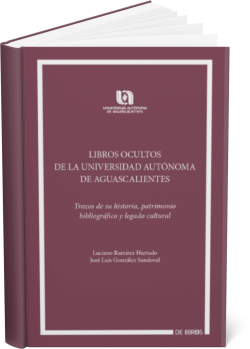THE HIDDEN BOOKS OF THE AUTONOMOUS UNIVERSITY OF AGUASCALIENTES: Pieces of its history, bibliographic heritage, and cultural legacy
Synopsis
In the field of antique books, one of the most fascinating lines of research is the reconstruction of a library’s historical collection. Most libraries have been formed by the accumulation of collections from various origins, meaning the work ultimately takes multiple directions. If, in addition, a walled-in library is involved, the task becomes even more complex—but no less thrilling.
The authors, Dr. Luciano Ramírez Hurtado and Lic. José Luis González, members of the Universidad Autónoma de Aguascalientes, approach this research from different perspectives—one as an academic and the other as a librarian—yet both with a researcher’s profile. Together, they have brilliantly unraveled the intriguing history of the antique collection of a modern university and revealed its composition, highlighting the literary treasures gathered over time to form a magnificent archive.
At the Convent of the Immaculate Conception of San Diego (Dieguinos) in Aguascalientes, the friars were compelled to hide part of their books—around 200 volumes—those they deemed most valuable, to protect them from potential destruction during turbulent times. A few works triggered the discovery, which could have turned into a tragedy if not for the diligence of a library employee, the intervention of academic authorities, and the subsequent treatment of the collection by librarians and faculty in a collaboration characteristic of university libraries. Thus, beyond the mere excitement of the discovery, what truly matters is the journey through the history of this collection and the care it has received thanks to the dedicated work of numerous professionals. This conventual library, along with its building, became part of a secular institution that underwent various transformations, making its history even more intricate: from the School of Agriculture to the Scientific and Literary Institute (under different names), then the Autonomous Institute of Science and Technology, and ultimately, the Universidad Autónoma de Aguascalientes.
Thus, though unplanned, this conventual collection ultimately found its way to the university. Today, it is complemented by volumes from other libraries (convents, the Girls’ Lyceum, the Municipal Library, the Seminary, and the personal collection of Dr. Jesús Díaz de León), as the authors thoroughly describe, enriching the collection further. The Universidad Autónoma de Aguascalientes undertook the task of preserving this archive, and later, a comprehensive project was launched to safeguard, catalog, and disseminate it. The initial cataloging was carried out by expert Elvia Carreño, who, with her wisdom and experience in conventual archives, brought recognition to a collection that holds true literary treasures. These treasures are the focus of the meticulous study in the second part of the book. What better way to honor a book and contribute to its preservation than by describing it, sharing it, and showcasing its value? For our libraries to be preserved and appreciated, they must be cataloged and made known—an endeavor the authors have masterfully undertaken.
This book, therefore, combines two distinct yet complementary perspectives. On one side, that of a prolific historian, recognized locally and nationally for his studies in art history; on the other, that of a tireless university library professional with deep knowledge of the antique collection studied in this work. Historical scholarship and bibliographic expertise thus come together, offering a book that underscores the urgency of studying the antique collection of the Universidad Autónoma de Aguascalientes Library—because within its volumes lies a crucial part of the university’s history.

Downloads
Published
Series
Categories
License

This work is licensed under a Creative Commons Attribution-ShareAlike 4.0 International License.













